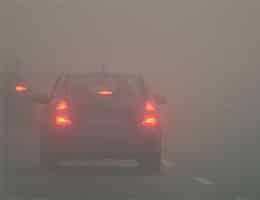 The etymology of the term fog takes us to the Latin word nebŭla . The concept is used to refer to a cloud that is at low altitude and that, due to the drops that concentrate on it, threatens visibility .
The etymology of the term fog takes us to the Latin word nebŭla . The concept is used to refer to a cloud that is at low altitude and that, due to the drops that concentrate on it, threatens visibility .
It should be remembered that clouds are formed by the condensation of water vapor : when numerous water droplets come together and remain suspended in the atmosphere, clouds emerge. If the clouds are very close to the surface and prevent seeing more than a kilometer horizontally, they produce the phenomenon known as fog .
Fog, in short, is developed by water droplets that are in suspension. The humidity in the air condenses, but since the water particles are not so large, they do not precipitate (as happens with rain ), but remain in the air.
The mass of fog that extends in a certain area is known as a fog bank . Fog banks carry various dangers since, by reducing visibility, they can encourage accidents .
On a route (highway), fog forces motorists to drive at low speed and with their lights on. Driving a vehicle at a speed of 100 kilometers per hour , for example, involves a great risk, since fog prevents you from seeing more than a kilometer away .
The use of lights when driving on foggy days is necessary to maximize the chances of being seen by other drivers, as visibility can drop considerably to critically low levels. Both the low beam and the position light are useful in this context, although the ideal one is the so-called fog light , which has its front and rear versions. The first one is optional, but the rear one is mandatory in cases of higher density .
 The secret of the fog light is that it is projected very close to the ground, where fog does not usually accumulate, and is specially designed not to generate annoying or dangerous reflections . Of course, its excessive or reckless use can cause visibility problems for other drivers, which is why it is imperative to pay attention to its results at all times. The light that we should never use in case of fog is the long one, since its reflection is absolutely counterproductive for everyone.
The secret of the fog light is that it is projected very close to the ground, where fog does not usually accumulate, and is specially designed not to generate annoying or dangerous reflections . Of course, its excessive or reckless use can cause visibility problems for other drivers, which is why it is imperative to pay attention to its results at all times. The light that we should never use in case of fog is the long one, since its reflection is absolutely counterproductive for everyone.
As also mentioned above, speed is one of the most important variables in minimizing the risks of fog. It is recommended to drive slowly, adapting to the reduced viability, so that the inability to see the rest of the cars does not lead to an accident. There are rules that help us calculate the ideal speed, such as the one that advises us to travel at the same number of kilometers per hour as the visibility value expressed in meters (for a visibility of 15 meters , for example, the speed should not exceed the 15 kilometers per hour ).
The windshield wipers should be used frequently to keep the glass free of fog . Inside the vehicle, ventilation can be used for the same purpose; If this is not enough, then it is recommended to open the windows slightly. Regarding conduct on the highway, it is important to stay in the right lane and not try to pass anyone. If the density of the fog prevents us from seeing the elements around us, at least we can be guided by the continuous white line of the road.
It is important to mention that, when low clouds affect vision but provide visibility of more than one km, we speak of fog and not fog. It can be stated, in this way, that fog is less dense than fog.
